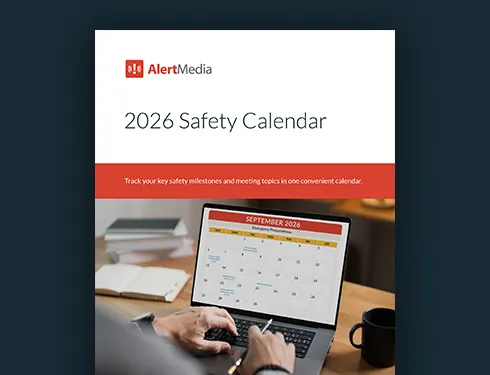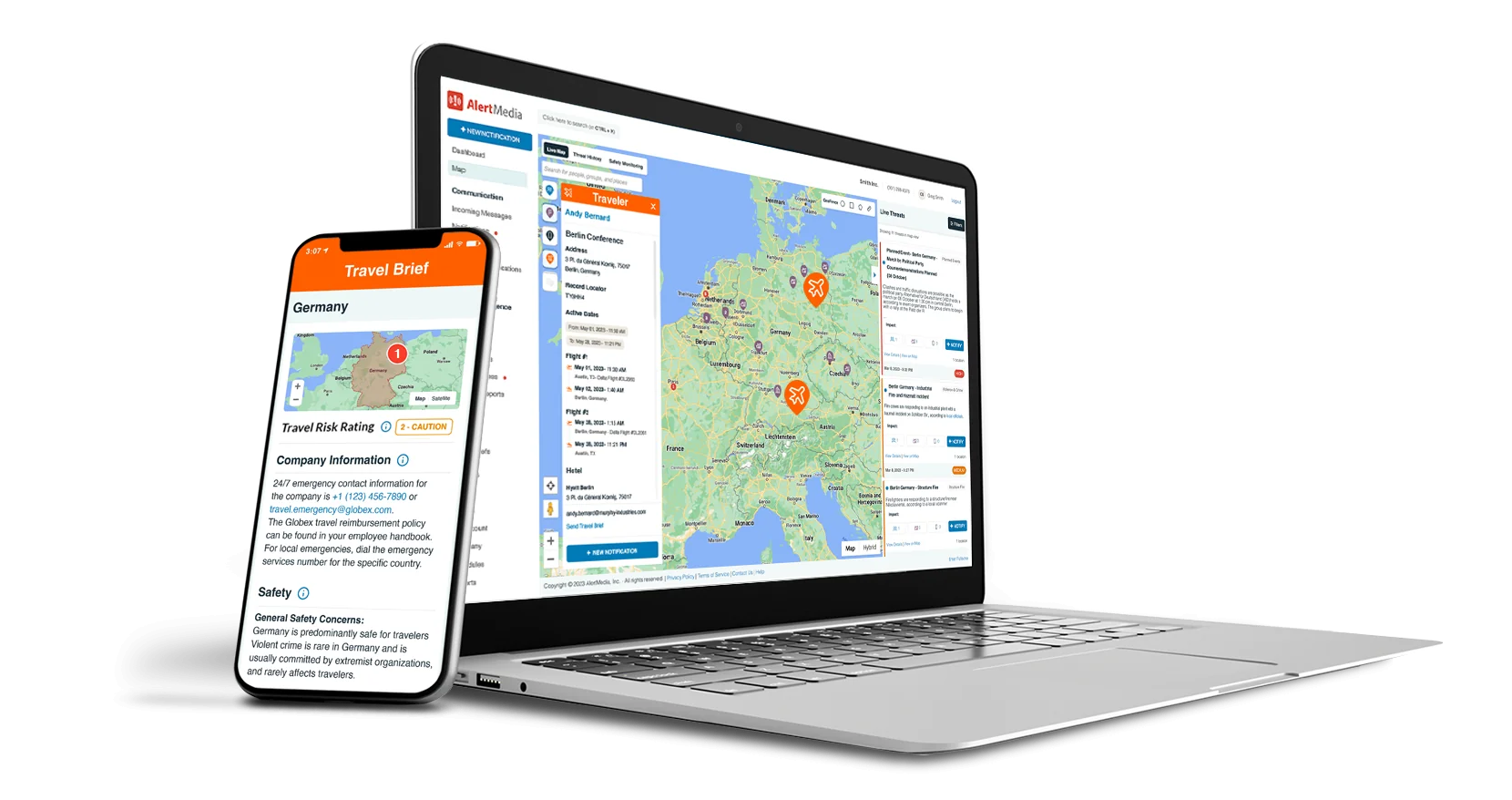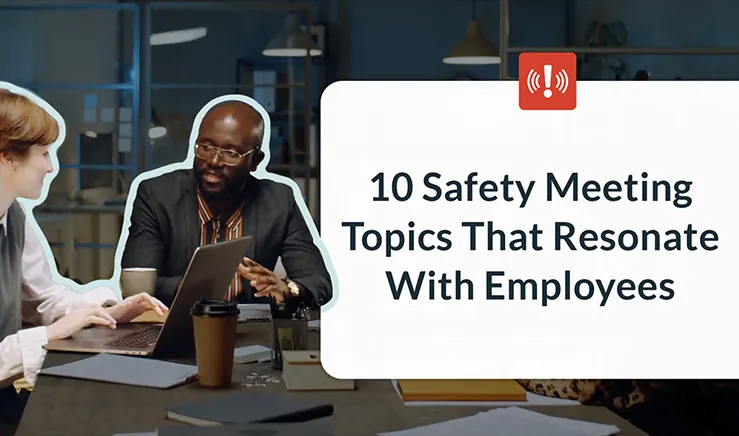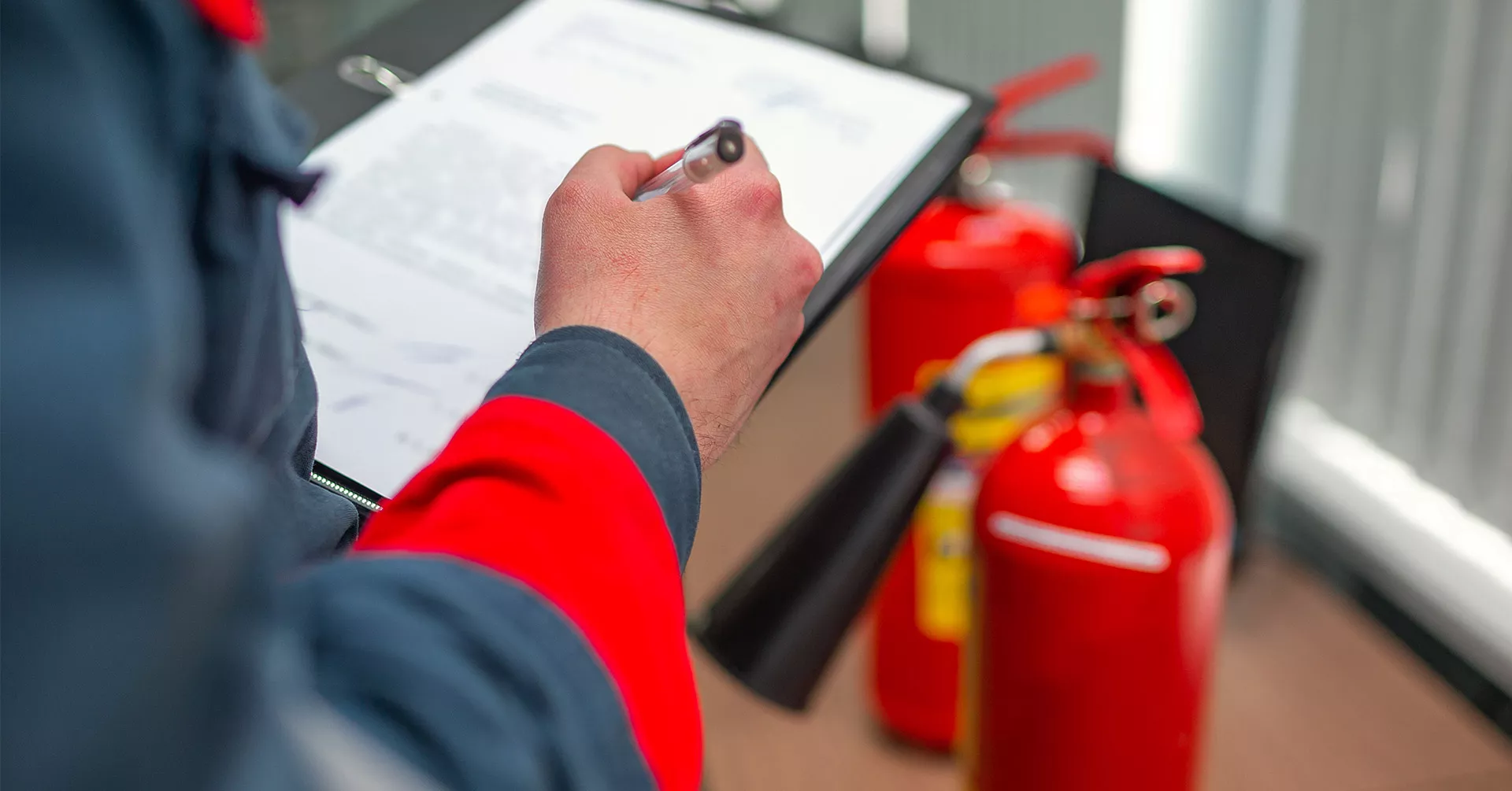Keeping up with the latest trends is a great way to stay on top of what’s working. Find out what safety trends are in for 2026 and hear from leading experts about the strategies they’re implementing this year.

2026 Workplace Safety Trends: 6 Ways to Support Your Employees

At AlertMedia, we have the privilege of talking with safety experts on a regular basis to learn what businesses should be doing to protect their employees and operations—and what safety and security leaders find most effective.
We don’t like keeping all this knowledge to ourselves.
Here are six safety trends we see gaining traction in 2026. We’ll explore what you can do to make sure your employees are getting the best, safest possible work environment when they clock in.
2026 Safety Calendar
What Are the Major Workplace Safety Trends in 2026?
In 2026, workplace safety is no longer just about compliance—it’s a strategic imperative woven into every aspect of business operations. As organizations continue to navigate hybrid work, evolving threat landscapes, and emerging technologies, safety leaders are being asked to do more with fewer resources while maintaining a strong culture of preparedness and duty of care.
This year’s safety trends reflect a growing emphasis on proactive risk management, data-informed decision-making, and a holistic view of employee well-being. Businesses are investing in scalable, tech-enabled solutions to anticipate threats and respond faster, while also prioritizing mental health, workplace violence prevention, and stronger collaboration between security, HR, and business continuity teams.
From the rise of AI-enhanced emergency communications to a sharper focus on inclusive safety programs and climate resilience, these trends signal a broader shift: Safety is becoming smarter, more connected, and more people-centric than ever before.
Here are the key workplace safety trends shaping how organizations protect their people and operations in 2026.
1. Psychological Safety & Mental Health
While physical safety is still high on the list of priorities for businesses, there is a whole other area of safety that’s receiving much more attention. Our State of Employee Safety Report found that 48% of employees would grade their employers’ focus on mental health a “C” or worse.
Psychological safety and mental health and wellness may be the “trendiest” safety topics for 2026, but they are by no means a fad that will fade. Mental health and burnout are slowly being destigmatized, and more focus is being paid to how psychological safety affects employees in the workplace. In fact, mental health in the workplace is one of the top priorities of the U.S. Surgeon General’s office, which recently published an entire framework so businesses have the resources they need.
“While it was a popular topic before the pandemic, psychological safety has become that much more so due to its relevance to agility, diversity, inclusion, and remote working.”Dr. Rajni Walia Vice President, DEKRA North America
What is psychological safety?
Dr. Rajni Walia—an organizational psychologist, consultant, and Vice President of DEKRA North America—sat down with us on The Employee Safety Podcast to discuss just that. “Psychological safety is the ability to show and employ oneself without fear of negative consequences of self-image, status, or career,” she explained. “And essentially, it’s a shared belief that the team is safe for interpersonal risk-taking, that it is safe for them to ask questions during meetings. It is safe for them to disagree with their manager or peers. And in psychologically safe teams, people feel accepted and respected.”
How do you foster psychological safety and mental health on your team?
Approaching a subject as sensitive as mental health issues in the workplace can feel intimidating, but it’s necessary to create a positive and holistically safe work environment. But the stakes couldn’t be higher. “Today, three out of four employees in businesses surveyed have said that they have anxiety, depression, and fear, and that dramatically affects their job performance,” said Brian Searcy, Founder and President of Paratus Group.
One way to help navigate mental health is through a common safety and security strategy: situational awareness. Brian explains that the key is to be able not only to recognize employees who may be struggling but also to know when you can intervene and when you should seek additional help. Train your middle and upper management on what to look out for in their teams, as well as when a situation should be escalated to your HR or people team. And remember, this is about more than preventing mental health absenteeism—this safety trend is about providing for the total wellness of your employees, so they can be both physically and mentally safe at work.
Dr. Walia also gave some strategies that can help with creating positive and safe team environments:
- Scale back the sense of stress and urgency for the work your teams are doing: This doesn’t mean removing all deadlines, but you should take a hard look at what is reasonable from a productivity standpoint. If every task is framed as the most important and needs to be done ASAP, then employees won’t be able to accurately prioritize, and that can have serious mental health implications.
- Provide recognition and support for your employees: A gold star can go a long way, so don’t be afraid to give your team members the shoutouts they deserve. But don’t forget to offer support for those who might need a little more help.
- Ensure your physical workplace is safe and in good condition: Psychological safety and physical safety are very closely tied. If your workers are at risk from physical hazards, they aren’t going to feel safe.
2. Safety Beyond the “Workplace”
Workplace safety in 2026 is not going to be limited to protecting employees in an on-site facility. The scope of employee safety is stretching to include remote work, business travel, and even time off the clock. There are simply more spaces where people are expecting their employer to have their back.
Up to 45% of employees are working remotely in some capacity, and despite some attempts to move employees back into facilities, remote work isn’t going away. And business travel is back in a major way: The U.S. Travel Association reports that business travel is expected to continue to grow through 2026. Safety management is no longer limited to mitigating hazards in your workspace—you need to be mitigating risks wherever your employees are—all around the globe.

“Our number one goal is always to take care of the health and safety of our partners. And so, whenever we look at anything in any of our processes, procedures, or response capabilities, we ask how do we make sure that our employees are safe during a disaster? And make sure that they’re prepared for disasters both at work and at home.”
— Justen Noakes, Director of Emergency Preparedness at H-E-B
3. Extreme Weather Preparedness
Weather, specifically severe weather events and natural disasters, are some of the top threats to businesses in 2026, and the growing emphasis on weather preparedness is less of a trend and more of a necessity. These events are increasing not only in frequency, but also in severity. And you want your business to be ready long before the event hits.
It doesn’t matter where your business is located—your business is bound to see higher rates of extreme weather, particularly during “off” seasons we may take for granted. Wildfires in drought-prone areas are no longer limited to the summer and fall, and hurricanes are starting earlier and sticking around longer. Even tornadoes are becoming more frequent outside of Tornado Alley.
There are also infrastructure implications with these severe weather events, particularly with power outages. Jason Moreland, Senior Meteorologist at AlertMedia, explained, “Businesses should be prepared for disruption for longer durations. Climate Central, a nonprofit organization, found that 83% of all power outages were caused by weather. This was a significant increase from the prior decade. This is partly due to increasingly severe weather but also aging infrastructure. And it’s happening across the globe, from Cuba to Texas to China to Europe.”
How do you prepare your business for worsening weather events?
To get your business on the right track, we’ve pulled some of the recommendations from our 2026 Threat Outlook Report. You can download the full report here to learn more about the weather risks (and other top threats) your business will likely deal with in the year ahead.
Your approach to weather preparedness depends on your location and specific threats, so the first and most important thing you can do is determine what you’re up against. Perform a threat assessment for your business location and any distributed locations where employees are based. Once you know your risks, you can take meaningful steps to develop response plans. Here’s how:
- Prepare for coinciding emergencies: Most of the time, a storm is not just a storm. Severe weather is a major factor in other emergency situations, such as power outages, infrastructure damage, and transportation blockages. Some weather events, like hurricanes, can cause supply chain disruptions on essential goods, like gas. When you plan for severe weather, also coordinate plans for the other synchronous emergencies that are likely to emerge.
- Promote individual employee awareness and preparedness: Larger-scale threats, such as natural disasters and severe weather, are going to affect more than just your single business location. When your employees have family members in harm’s way, they are going to be preoccupied with the situation at home. Support your employees in developing personal weather preparedness plans ahead of a disaster so they can focus on their part in the planned business response during a crisis.
- Add redundancies: When a critical system fails or a primary safety leader is unavailable, you need a backup plan. Integrate redundancies in your weather preparedness efforts, such as having multiple backup generators and multiple people trained to conduct your response plans. Additionally, ensure you have deployed every communication channel to reach your employees with critical information and you have trained multiple people to send alerts.
4. Emphasis on Accessibility and Inclusivity Training
In the same vein of psychological safety, accessibility and inclusivity are rising workplace safety trends and topics safety professionals should take seriously. A lack of commitment to inclusivity and accessibility can cause a lack of trust and psychological safety, which can result in poor performance, low employee engagement, higher mental health absenteeism, and even increased safety issues.
Vanessa Mathews, Founder & Chief Resilience Officer of Asfalis Advisors, talked through this issue on The Employee Safety Podcast. “When we ask, ‘what are some of the challenges that Black, Indigenous, and people of color (BIPOC) might be facing within the workplace?’ there are three things that continuously come up. One is acceptance, two is authenticity, and the third is values. Looking at those three components, what we’re seeing is there’s a trust deficit with minority, specifically BIPOC, communities within the workplace,” she told us.
—Vanessa Mathews, Asfalis Advisors
While this is a systemic issue and affects most companies at every department level, it’s highly applicable to security leaders and occupational safety teams. Safety leaders have an obligation to protect employee health and safety in every capacity, and that can’t happen if you ignore the mental health repercussions of non-inclusive and non-diverse teams.
According to Dr. Tracy Brower, sociologist and author, it’s going to be a trend that sticks around because it works. “When we attend to the well-being of people, we see this pay off for the business … I think it’s here to stay. I think it’s a trend that will last, and I think that it has enough payoff for both people and business that it will be something that remains central and strategic for business.”
5. Company-Wide Safety Culture
Fostering a positive workplace culture has been a trend for several years, and safety is finally joining in. Workplace safety is not just about “guns, gates, and guards” anymore—it’s about creating a top-down culture that prioritizes safety and security every step of the way. Here are two ways we are seeing this happen in 2026:
How can you foster stronger safety leadership?
Culture starts at the top, so building a solid leadership team that is cohesively aligned with safety is everything. Eric McNulty, Associate Director of The National Preparedness Leadership Initiative (NPLI) at Harvard University, recommends building stronger safety leadership by including your business executives in your safety processes as much as possible and building a strong relationship between your safety team and your upper management.
“The folks in the C-Suite don’t just talk to the safety and security people when something bad has happened. They’ve started that conversation and started building that relationship much earlier,” Eric explains. “It’s so important to get executives to, at least once a year, go through a full-scale exercise of some sort. Because you want them to know what’s going to happen. You want to take care of any questions or objections they have in that setting as opposed to during a real incident.”
With strong safety leadership at the top of your business, and with the buy-in and resources you need to prioritize worker health, your team will be much better able to handle whatever emergency situations come your way.
Watch this video to learn the fundamentals of compelling safety talks, discover new topic ideas, and get facilitation tips.
How can you improve safety training?
Emergency response doesn’t come naturally for most people. In fact, generally, people will react to a crisis situation in the opposite way that you want, with panic or hesitation, unsure of what to do. That’s where training comes into play. AlertMedia’s report on employee safety showed that employees want better safety training and improved communication about safety resources. Arming your people with information and practice on what should happen during an emergency will promote better safety culture overall.
—Jason Freeman, Corporate VP of Operations, Public Safety, Maintenance & Engineering at Six Flags
But 2026 is raising the standards for your safety training. Your employees need more than a single, optional, generic safety training. Your training program should be specific to the situations your team faces and should give specific instructions.
For example, Shawn Rafferty, safety training expert and owner of SPR Group, LLC, laid out what you want if you’re investing in running active shooter preparedness training: “You should have an active shooter training program that covers everything from preparing your staff and your facility—meaning situational awareness, observation awareness, what you do and what you look for—all the way to the 911 call, the actions you take when the incident is going down, and the communication process during the incident.” You also want this training to be mandatory and performed on a yearly—or even quarterly—basis to make sure that these safety procedures are top of mind.
6. Artificial Intelligence
Every year, advancements in artificial intelligence seem to take over the news. This is especially true in 2026, as generative AI explodes in popularity. But these new technologies, while exciting, have the potential to cause significant harm due to their ability to create and spread misinformation, disinformation, and false images and videos with ease. They also have very few safety regulations.
The key to AI risk management is teaching your employees how to spot AI-generated content and how to think critically about what they read.
—Ian Phillips, Director of News and Media at The United Nations
How can you mitigate the risks involved with AI?
Keep humans involved in your threat monitoring
Many threat intelligence systems use AI to gather and sort through news and events. But in your search for the right intelligence solution, prioritize those that offer human-vetted intelligence to mitigate the risk of launching a response to a false alert. You can learn more about how human-in-the-loop systems can help your organization by reading The Future of Threat Intelligence: Where AI Meets Human Insight.
Educate your team on the risks of misinformation
Your employees must know the risks of misinformation and inaccuracy, especially if your business uses AI in core functions. Incorporate online media literacy in your compliance training program to teach employees how to identify and avoid spreading misinformation. When your people can use critical analysis to verify information and claims, they will be less likely to buy into falsehoods or fall prey to scams online.
Focus on Workplace Health and Safety
Workplace safety has always had a singular goal: protect employee wellbeing. Everything your safety team—and the entire organization—does comes back to this. From the OSHA-mandated tactics for lowering workplace injuries and work-related fatalities, like providing personal protective equipment (PPE), to the less obvious strategies like encouraging psychological safety, every effort to improve health and safety is going to pay off.
Safe employees are your business’s best investment for long-term success. By implementing these safety trends into your existing safety program (and continuing with the work that doesn’t make headlines) you’re going to see a boost in your employees’ trust and effectiveness—and your company’s overall growth.








